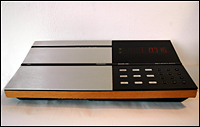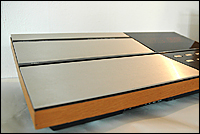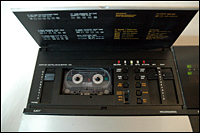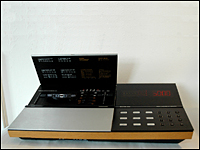Beocord 9000 |
Made in Denmark by Bang & Olufsen - Struer Designed by Jacob Jensen |
|||||||||||
|
sold
|
|||||||||||
 |
 |
|||||||||||
 |
 |
Instruction book for Beocord 9000 in Danish Download - (PDF 11.430 KB) Instruction book for Beomaster 6000 in Danish Download - (PDF 3.850 KB) |
||||||||||
Beocord 9000: "The King of cassette recorders" From Beoworld For serious music lovers whose major interest was in recording their own professional-quality tape library, Beocord 9000 offered even more facilities and higher performance capabilities than Beocord 8004. It could therefore be chosen as an alternative in Beosystem 8000 when its primary playing and recording functions could be operated via Beomaster 8000's remote control Terminal. While Beocord 9000 shared all of Beocord 8004's advanced engineering techniques and microcomputer intelligence, its superior sound quality was achieved by the addition of a unique tape calibration system. This computerised system measured the four vital recording parameters of each individual tape - bias, equalisation, sensitivity and distortion level - and actually adjusted the deck's own recording characteristics to match them exactly. As a serious recordist, you no doubt had your particular favourites
among the many brands and types of cassette tapes available when Beocord
9000 was released. And your particular hates too! Good results are partly
a measure of how closely the tape's technical characteristics match
the 'average' recording parameters for which your machine is adjusted
during manufacture. The tape brand you have identified as 'the best'
may, on another type of recorder, sound quite poor. The fact is that
tape manufacturers design their tapes for use with as many different
recorders as possible, while the equipment manufacturers design their
decks to use all brands and all types of tape. So both industries rely
on a set of 'average' specifications. What is more, Beocord 9000 could show you on a digital read-out panel
what those settings were, and could store them in its computer memory.
Calibration data for each of the three tape types - ferric, chrome and
metal - could be stored in this way. The tape calibration process was fully automated and took about 9 seconds from the touch of a button. Beocord 9000 featured a new type of Sendust/ferrite tape head, specially designed for Bang & Olufsen. It had separate tone-gaps for recording and playback, housed in a single casing. Compared to a combination head, this arrangement afforded wider frequency response and constantly correct azimuth between recording and playback. The real-time counter was similar to that used in Beocord 8004 but had an additional feature. Beocord 9000 could calculate and display the time remaining on the tape, as well as the time already consumed. In other respects the operation, facilities and dimensions of Beocord 9000 are as described for Beocord 8004. Beocord 9000 could be used as a stand-alone tape cassette recorder or as part of Beosystems such as Beosystem 6000 or Beosystem 8000.
|
||||||||||||
